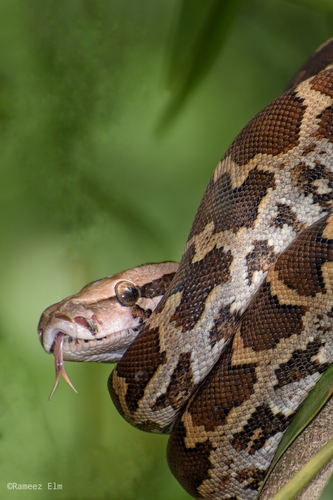
Indian Python
The majestic Python molurus, or Indian Python, thrives in South Asia's forests and grasslands. Renowned for its immense size and strength, this non-venomous constrictor aids in pest control by preying on rodents, showcasing nature's intricate balance through its vital ecological role.
20-30 years
Lifespan
Length: 2.44 - 3.35 m
Size
Brown, Yellow, White, Tan, Dark
Color
2-3 years
Age of Sexual Maturity
Low
Aggression
Near Threatened
Conservation Status
Decreasing
Population Trend
Characteristics
Python molurus, commonly known as the Indian Python, is a large non-venomous snake found in South Asia. It inhabits diverse environments such as forests, grasslands, and marshes. Known for its impressive size, it can grow over 20 feet long. The python is a constrictor, using its muscular body to suffocate prey. It plays a vital role in controlling rodent populations, thus maintaining ecological balance.
Distribution Range of the Indian Python
Python molurus, commonly known as the Indian python or Burmese python, is native to South Asia and Southeast Asia. Its geographical distribution includes countries such as India, Nepal, Bhutan, Bangladesh, Myanmar, Thailand, Laos, Cambodia, Vietnam, and parts of China. The species is also found in the Indo-Malayan region.
Indian Python's Habitat
Environmental Conditions
Python molurus typically inhabits a variety of environments ranging from lowland forests to grasslands and marshes. It thrives in warm, humid climates, often near water bodies such as rivers, lakes, and swamps. The species is adaptable and can also be found in agricultural areas, given the presence of suitable prey.
Ecological Niche
As a large non-venomous constrictor, Python molurus plays a crucial role as an apex predator in its ecosystem. It primarily preys on mammals, birds, and occasionally reptiles, utilizing its camouflage and stealth in dense vegetation to ambush prey. The species contributes to controlling the populations of its prey and maintaining ecological balance.
Copyright @ Nature Style Limited. All Rights Reserved.
 English
English